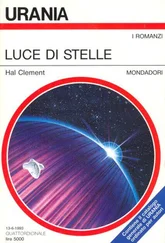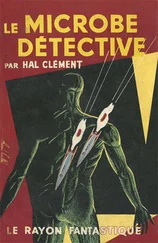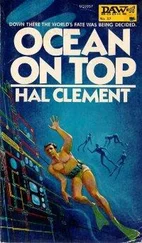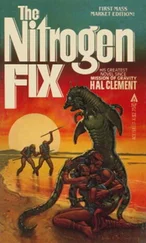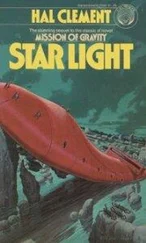The other problem was demanding his attention, anyway. Some of the indicators on the board in front of him were fluctuating. He had learned the panel fairly well in the last day or two, and was able to interpret the readings himself. It seemed, he noted, that pressure and temperature were both going down in the cargo chamber of the projectile. Well, that was reasonable. There were no heaters working, and the pressure would naturally drop as the gas cooled. Then it occurred to him that the temperature of Planet Three was low enough to freeze sulfur, and his test units would be covered with a crust of the stuff. Something should be done about that.
As a matter of fact, most of the pressure drop was due to leakage; the cargo door had cooled and contracted sufficiently to let air escape slowly around its edges. Ken, however, did not think of that; he found the appropriate switch and tripped it, watching the pressure drop instantly to zero as the door opened. The temperature was almost unaffected — if anything, it dropped more slowly, for the recording pyrometers were now insulated by a vacuum and the expansion of the gaseous sulfur into empty space had had no cooling effect to speak of. A touch on some of the switches which were designed to heat the test substances showed that the little furnaces were still in working order, and after a moment’s thought Ken allowed the magnesium and titanium specimens to come up to melting temperature. Then, sure that they were as free of contaminating gases as could be managed, he watched the recorders as the samples cooled again. Through all this, the torpedo hurtled on, unaffected by the extra drain on its power.
For some minutes Ken continued to wait, one eye roving over the dials and the other glancing casually about the great room; but finally he decided that Allmer had picked a good time to go off duty. He did not feel tired himself, but gradually he became convinced that there must be something a little more constructive to do. He suspected that, even if there were to be any drugs around the station, they would not have arrived yet, so there was no use making a search for them; but preparations might be made to see just what came back in the other torpedo.
As a first step, it might be well to go up to the observatory to find out just who was guiding that missile. If it were Drai himself, it would be a point in favor of Rade; if not, it would be another person from whom information might be obtained. There seemed little doubt that no one would be allowed to run the trading torpedo who did not know exactly what was being obtained on the third planet — the Planet of Ice, as Ken was coming to think of it (not that he thought of ice as a substance; he had never seen the material and would have thought of it as hydrogen oxide in any case. Planet of Solid Sulfur comes closer to the way he would have expressed the thought).
Ken was basing his supposition on his memory of how Drai had refrained from naming the substance obtained from the planet; and, determined to find at least one small brick of data to add to his edifice of information, the investigator headed up the spiral ramp toward the observatory at the station’s highest level. No one attempted to stop him on the way, though he met a couple of workers who flipped tentacles in casual recognition. The door of the observatory was not locked, as a trial push showed, and he entered, still without opposition. He was braced for a prompt request to depart, and was a little surprised when nothing at all was said. A moment later, when his eyes had become accustomed to the dimness of the big room, he realized to his chagrin that no one was there.
“No business secrets loose so far,” he muttered.
He was about to return the way he had come, when it occurred to him that he might as well make sure of that fact. There were not many places where paper work of any sort could be kept, at least at first glance; and these he rapidly covered. They were mostly cabinets built under instrument panels, and seemed to contain nothing but tables of the motions of the planets of this system. These seemed rather valueless; their most probable use would be in navigation, and Ken could not imagine anyone’s wanting to navigate anywhere in this system except to the world of Ice. They could also be used to direct the instruments, if anyone wanted to look at the planets in question; but that seemed even less helpful.
Under the beam setting controls was a small drawer which also contained two sets of numbers — again, spatial coordinates; but this time Ken froze to attention as he realized that one set at least did not refer to planets — they contained no cyclic term. The set was short, consisting of six groups of numbers containing from six to ten digits each; but he recognized them. The first identified by spectrum a beacon star; the next three were direction cosines, giving the three-dimensional bearing to another sun; the fifth gave a distance. Normally he might not have recognized or remembered the lengthy figures; but those were the coordinates of the blazing A-class sun which warmed Sarr, his home planet. The final number was another range; and beyond question it represented the distance from the present point of observation to the listed star. Ken knew enough of the standard navigational notations to be sure of that.
The other set of numbers, then, must give the direction of the same sun relative to some local set of coordinates; and not only was he ignorant of the coordinates, but the numbers were too long to remember. To copy them would be suicide, if anything more than commercial secrecy were involved. For long minutes Sallman Ken stood frozen in thought; then, abruptly, he slipped the sheet back into the drawer, closed the latter, and as quickly as was compatible with caution left the observatory. Since the information was there, it would not do for anyone to get the idea he had been there for any great length of time. It would be better if no one knew he had been there at all, but he had been seen on the way up the ramp. He proceeded to get back to his own quarters and assume an attitude of repose, though his mind still raced furiously.
He knew his distance from home. Evidently the twenty-two days of the journey to this system had not been spent in straight-line flight; the distance was only two hundred twelve parsecs. Score one for Rade; that would be an expensive business precaution, but a normal criminal one.
The direction home from this system he did not know. It did not matter too much anyway; what the Narcotics Bureau would want would be the opposite direction, on Galactic coordinates, and there would be no mathematical connection between the two except a purely arbitrary formula which would be harder to memorize than the direction itself.
Of course, the beacon listed in the stellar coordinates was probably visible from here; but could he recognize it with any certainty without instruments? The instruments were available, of course, but it might not be wise to be caught using them. No, orientation was definitely the last job to be accomplished in his present location. At any rate, one fact had been learned and one point of probability had been added to the Rade theory. Sallman Ken decided that made a good day’s work, and allowed himself to relax on the strength of it.
Nearly three of Sarr’s thirteen-hour days passed uneventfully before the relay station circling Earth picked up the approaching torpedoes. As Feth Allmer had predicted — and Laj Drai had confirmed, after checking with his tables — the signals from the planted homing unit were coming from the dark side of the planet. Drai phoned down from the observatory to the shop, where Ken and Allmer were engaged in decelerating their missile.
“You may as well drop straight down as soon as you swing around to the dark side,” he said. “You will pick up the beacon if you spiral in, keeping between forty and fifty-five degrees above the plane of the planet’s orbit, measured from the planet’s center. The beam can be picked up by your torpedo more than forty diameters out, so you can’t possibly miss it. You’d better ride the beam down automatically until you’re into atmosphere, then go manual and move off a couple of miles if you plan to go all the way to the ground. If the natives are camping near the beam transmitter, it would be a pity to touch off your chemicals right in their midst.”
Читать дальше

